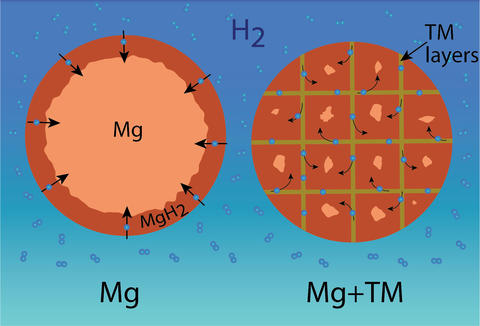
Particles of pure magnesium (left) can only collect a limited amount of hydrogen on their outer surfaces, and the process is slow. But when the magnesium is doped with iron (right), far more hydrogen is delivered through the iron layers, which also results in much faster charging.
With a nod to biology, scientists at the National Institute of Standards and Technology (NIST) have a new approach to the problem of safely storing hydrogen in future fuel-cell-powered cars. Their idea: molecular scale "veins" of iron permeating grains of magnesium like a network of capillaries. The iron veins may transform magnesium from a promising candidate for hydrogen storage into a real-world winner.
Hydrogen has been touted as a clean and efficient alternative to gasoline, but it has one big drawback: the lack of a safe, fast way to store it onboard a vehicle. According to NIST materials scientist Leo Bendersky, iron-veined magnesium could overcome this hurdle. The combination of lightweight magnesium laced with iron could rapidly absorb—and just as importantly, rapidly release—sufficient quantities of hydrogen so that grains made from the two metals could form the fuel tank for hydrogen-powered vehicles.
"Powder grains made of iron-doped magnesium can get saturated with hydrogen within 60 seconds," says Bendersky, "and they can do so at only 150 degrees Celsius and fairly low pressure, which are key factors for safety in commercial vehicles."
Grains of pure magnesium are reasonably effective at absorbing hydrogen gas, but only at unacceptably high temperatures and pressures can they store enough hydrogen to power a car for a few hundred kilometers—the minimum distance needed between fill-ups. A practical material would need to hold at least 6 percent of its own weight in hydrogen gas and be able to be charged safely with hydrogen in the same amount of time as required to fill a car with gasoline today.
The NIST team used a new measurement technique they devised that uses infrared light to explore what would happen if the magnesium were evaporated and mixed together with small quantities of other metals to form fine-scale mixtures. The team found that iron formed capillary-like channels within the grains, creating passageways for hydrogen transport within the metal grains that allow hydrogen to be drawn inside extremely fast. According to Bendersky, the magnesium-iron grains could hold up to 7 percent hydrogen by weight.
Bendersky adds that the measurement technique could be valuable more generally, as it can reveal details of how a material absorbs hydrogen more effectively than the more commonly employed technique of X-ray diffraction—a method that is limited to analyzing a material's averaged properties.

